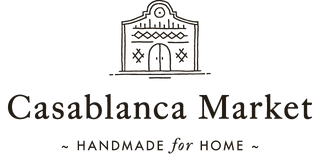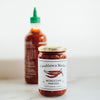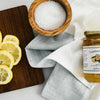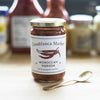7 Sustainable Steps to Handmade Moroccan Leather
- by Katia Essyad
Moroccan leather is deemed some of the world’s best for its soft and durable personality–the exquisite product of a generations-old traditional process that remains largely unchanged to this day.
Every expert Moroccan leather craftsman takes great pride in their leather tanning recipe, which yields the beautiful handcrafted Moroccan leather creations we carry at Casablanca Market, from Morocco to you. Handmade Moroccan leather, just like every product at Casablanca Market, has a story.
Here are the seven sustainable steps behind Moroccan leather:
1. Choosing the Hides
All Moroccan leather is made with either a cow, goat, sheep, or camel hide–no part of the animal goes to waste. Once the skins arrive at the tannery, they’re separated into groups and prepared for their first bath.


2. Did Someone Say Bird Droppings?
The skins are then submerged into large stone vats of pigeon droppings, cow urine, lime, water, and salt, which softens and cleans the hide. Kid you not, these craftspeople are waist-deep in the stuff, massaging each skin to create that soft texture we all know and love. The process is entirely natural, much as it’s been for centuries. Don’t worry, there are many more steps before it reaches your doorstep!
3. Scrub a Dub Dub
After two or three days, artisans remove the hides and prep them for dyeing. This includes (brace yourself) scraping off all excess fat, hair, and skin–not the most glamorous part of the process but a vital one nonetheless.


4. Time to Dye
This is where the skins start to harness their personalities. They’re dipped in vats of poppies and henna for shades of red, indigo for blue, mint for green, saffron for yellow (which are the most expensive), and other natural dyes. No chemicals here!
5. Hung to Sun Dry
Once the skins reach their preferred shade, they’re hung in the sun to dry.


6. Off to the Markets
Once dry, the newly dyed leather skins are transported to Morocco’s many vibrant markets where they’re bought by artisans who handcraft these natural skins into gorgeous Moroccan leather goods.
7. Elegance in the Details
Yes, even the stitching is all hand done! Some Moroccan leather goods like Moroccan ottomans are hand stitched for functionality, while others like our Moroccan poufs boast detailed decorative designs hand sewn with various intricate patterns.
Every single step of the Moroccan leather-making process is done carefully by a skilled hand, which means every single piece of handmade Moroccan leather is individually unique. The leather speaks for itself.
- Posted in:
- leather
- moroccan leather
- morocco
- sustainable






